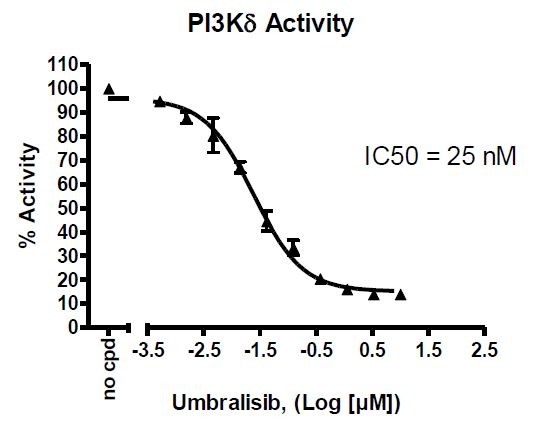PI3Kδ (p110δ/p85α) Assay Kit
Catalog #
79799
$535
*
●
●
Purchase
Description
The PI3Kδ (p110δ/p85α) Assay Kit is designed to measure PI3Kδ (PI3K-delta) activity for screening and profiling applications, using ADP-Glo® Kinase Assay as a detection reagent.
Need us to run inhibitor screens or profile your compounds against PI3Kδ (p110δ/p85α)? Check out our Kinase Screening Services.
●
Synonyms
PIK3CD, p110delta, Phosphoinositide-3-Kinase Catalytic Delta
PIK3R1, Phosphoinositide-3-Kinase Regulatory Subunit 1 (Alpha), GRB1, p85alpha, PI3K, pi3k
●
Product Data Gallery
Product Info
Storage and Usage
Citations
Assay Kit Format
Luminescent
Supplied As
The PI3Kδ (p110δ/p85α) Assay Kit comes in a convenient 96-well format, with enough purified recombinant PI3Kδ enzyme, PI3K lipid substrate, ATP and kinase assay buffer for 100 enzyme reactions.
Materials Required But Not Supplied
ADP-Glo® Kinase Assay (Promega #V6930)
Microplate reader capable of reading luminescence
Adjustable micropipettor and sterile tips
30°C incubator
Format
| Catalog Number |
Reagent |
Amount |
Storage |
|
| 40628 | PI3Kδ (p110δ/p85α) | 15 µg | -80°C | Avoid multiple freeze/thaw cycles! |
| 79334 | 5x Kinase assay buffer | 1.5 ml | -20°C | |
| 79686 | ATP (500 μM) | 100 µl | -20°C | |
| 40560 | PI3K lipid substrate (Packaged separately, Do Not Freeze!) |
500 µl | 4°C | |
| 79696 | 96-well plate, white | 1 | Room Temp. | |
UniProt #
p110δ: O00329; p85α: 181523
Background
PI3Ks (Phosphatidylinositol 3-kinases) are lipid kinases that phosphorylate PIP2 (phosphatidylinositol 4,5-bisphosphate) to produce PIP3 (phosphatidylinositol 3,4,5-trisphosphate), which plays important roles in fundamental cellular activities such as cell growth, survival, migration, and metabolism. In human cancers, gain-of-function mutations of PI3Ks are found frequently, suggesting that PI3Ks are closely involved in tumorigenesis and that PI3K targeting inhibitors may be promising anticancer drug candidates.
References
Zhao W., et al. Acta Pharmaceutica Sinica B, 7(1): 27-37 (2017)


